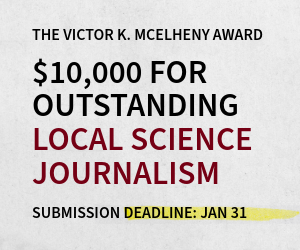- In the Book category, David Quammen for his book Spillover: Animal Infections and the Next Human Pandemic (W.W. Norton).
- In the Science Reporting category, “Witness to an Antarctic Meltdown” by freelancer Douglas Fox, published in Scientific American.
- In the Longform category, “Playing with Fire” by Patricia Callahan, Sam Roe and Michael Hawthorne, published in the Chicago Tribune.
- In the Science Reporting for a Local or Regional Audience category, “The Color of Bunny” by freelancer Hillary Rosner, published in High Country News.
- In the Commentary or Opinion category, “The Real Scandal” by freelancer Christie Aschwanden, posted on the blog The Last Word on Nothing.
Winners in each category receive a cash prize of $2,500, to be awarded at a reception on November 2, 2013, during the ScienceWriters2013 meeting taking place this year in Gainesville, Florida.
NASW established the Science in Society awards to provide recognition — without subsidy from any professional or commercial interest — for investigative or interpretive reporting about the sciences and their impact on society. The awards are intended to encourage critical, probing work that would not receive an award from an interest group. Beginning with the first award in 1972, NASW has highlighted innovative reporting that goes well beyond the research findings and considers the associated ethical problems and social effects. The awards are especially prestigious because they are judged by accomplished peers. NASW currently awards prizes in five categories: Books, Science Reporting, Longform Science Reporting, Science Reporting for a Local or Regional Audience, and Commentary or Opinion.
In Spillover, Quammen explores how a multitude of diseases — including Ebola, SARS, Hendra virus, HIV, and Q fever — originate in animals and pass to humans in the process called spillover. He also addresses the question of what the next major outbreak might be. The judges called Spillover “an altogether brilliant exploration of science’s quest to track and better define the origins and dynamics of zoonotic diseases.” They commented that “Master storyteller and fearless correspondent that he is, Quammen, in the company of intrepid, often quirky researchers, takes the reader on a series of amazing hunts deep into the ‘heart of darkness’ (in the Congo, China, Bangladesh and Saudi Arabia) in search of the animal hosts — the ‘reservoirs’ — of the pathogens that have crossed over.” Of the book’s writing, the judges said that, “One of the many strengths of this dazzling book is the wealth of scientific information it conveys without slowing its narrative drive, further testament to the author’s extraordinary talent.”
“Witness to an Antarctic Meltdown” was published in the July 2012 Scientific American. It describes the efforts of scientists to understand how fast the Antarctic is melting and its implications for sea-level rise. In his reporting, Fox accompanied scientists on an eight-week expedition to gather data on glacial melting. The judges called Fox’s article “a terrific example of explicatory science writing and a first-rate adventure story to boot. It offers a clear and concise description of the interplay between the meltdown of the floating Antarctic ice shelf and the collapse and seaward slide of the continental glaciers.” Of Fox’s journalistic initiative, the judges said “Having spent several months on the ice, Fox also has much to tell us about the perils and often punishing circumstances that researchers have to contend with in their efforts to measure and better understand the forces driving these linked phenomena as prelude to more accurate prediction of consequent rises in global sea level.”
“Playing with Fire” was published in the Chicago Tribune as a two-part series May 6 and December 20, 2012. It covers how toxic flame retardants made their way into such products as upholstered furniture, carpet padding, and diaper-changing pads. This occurred despite the fact that some of the compounds — when ingested by babies in breast milk or as contaminated dust — have been linked to neurological impairment, developmental problems, impaired fertility and other health risks. The judges called the series “compelling and impactful,” and commented that it was particularly appropriate to receive a Science in Society Award because “the deeply reported stories probed how certain lobbyists and scientists have systematically misled the public and regulators for years.”
“The Color of Bunny,” was published February 6, 2012, in the High Country News. It describes Rosner’s field trip with University of Montana biologist Scott Mills, in which the biologist gathered data for his field study of how the semi-annual color change in snowshoe hares may be affected by climate change. Of Rosner’s article, the judges said “This totally engrossing and engaging report from the field artfully describes efforts to better understand a biological phenomenon critical to animal survival, namely seasonal camouflage.” The judges pointed out the broader implications of the research, saying that, “While the story focuses mainly on a local, Montana-forest-dwelling population of snowshoe hares it also serves as a springboard for a broader-lensed discussion regarding conservationist ideas for dealing with climate change's coming impact on ecosystems.”
“The Real Scandal: Science Denialism at Susan G. Komen for the Cure” was posted on February 8, 2012, on the web site The Last Word on Nothing. It asserts that Susan G. Komen for the Cure — an organization advocating for breast cancer screening and research — ignored research on tumor biology to overemphasize screening. The judges called Aschwanden’s opinion article “persuasively argued, authoritative and highly informative.” In her commentary, Aschwanden took issue with the organization’s blame-the-victim tone and the false narrative that breast cancer is uniformly progressive and can only be treated if caught early. Such a position, wrote Aschwanden, ignores the perils of over-diagnosis and the potential for unnecessary and damaging treatments.
The final judging committee consisted of Ben Patrusky (Executive Director Emeritus, Council for the Advancement of Science Writing), Janet Raloff (Senior Editor, Science News) and Boyce Rensberger (retired science journalist). The Science in Society awards committee was co-chaired by Amber Dance, a freelance journalist and staffer at Alzforum.org, and Dennis Meredith, a freelance science writer and communication consultant.
Said Dance and Meredith, “We were particularly pleased to note that this year’s winners included multiple freelancers and a blog, showing that the Science and Society Awards recognize the quality of the reporting, regardless of whether it arose from individual initiative and appeared in new media, or from staff writers at traditional media outlets.”
In addition to the final committee, NASW thanks the volunteers who served on the preliminary screening committees:
Ewen Callaway (Nature), Phil Hilts (MIT Knight Science Journalism Program), Earle Holland (freelance), Lynne Friedmann (freelance), Alla Katsnelson (freelance), Robin Lloyd (Scientific American), Tom Maugh (retired), Steve Mirsky (Scientific American), Linda Marsa (contributing editor, Discover), Amy Maxmen (Nautilus), Seth Mnookin (MIT Graduate Program in Science Writing), Christine Peterson (Casper Star-Tribune), Paul Rogers (San Jose Mercury News), Tom Siegfried (freelance) and Brittany Steff (freelance).
Entries for next year's competition, for material published or broadcast in 2013, are due February 1, 2014. Entry forms will be available at www.nasw.org in December 2013.
The largest organization devoted to the professional interests of science writers, the National Association of Science Writers fosters the dissemination of accurate information regarding science through all media normally devoted to informing the public. Its 2,525 members include science writers and editors, and science-writing educators and students.
For questions or more information visit www.nasw.org or write director@nasw.org.
National Association of Science Writers, Inc.
PO Box 7905
Berkeley, CA 94707




